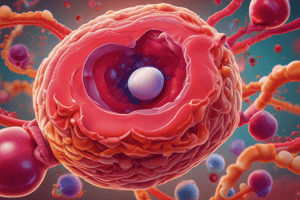Podcast
Questions and Answers
Which of the following is a nursing consideration for PCSK9 inhibitors?
Which of the following is a nursing consideration for PCSK9 inhibitors?
- Drug interactions (correct)
- 1st line option in most circumstances
- Myopathy
- Decreases efficacy of most oral medications
Which class of medication is mainly used if a patient has high triglyceride levels above 500?
Which class of medication is mainly used if a patient has high triglyceride levels above 500?
- Statins
- Anticoagulants
- Bile Acid Sequestrants
- Fibric Acid Derivatives (correct)
Which class of medication decreases the efficacy of most oral medications?
Which class of medication decreases the efficacy of most oral medications?
- PCSK9 inhibitors
- Fibric Acid Derivatives
- Bile Acid Sequestrants (correct)
- Statins
Which lipoprotein is the main transporter of cholesterol to cells?
Which lipoprotein is the main transporter of cholesterol to cells?
What is the protective mechanism of HDL (High-Density Lipoprotein) against atherosclerosis?
What is the protective mechanism of HDL (High-Density Lipoprotein) against atherosclerosis?
What are Edward Watkins' latest laboratory findings?
What are Edward Watkins' latest laboratory findings?
Which drug class is considered the best for lowering LDL cholesterol?
Which drug class is considered the best for lowering LDL cholesterol?
Which drug class is most effective at lowering serum TG?
Which drug class is most effective at lowering serum TG?
What is the mechanism of action of cholestyramine?
What is the mechanism of action of cholestyramine?
Which drug is no longer recommended except in patients with very high TG (>500)?
Which drug is no longer recommended except in patients with very high TG (>500)?
True or false: Dyslipidemia is a condition characterized by elevated blood lipids.
True or false: Dyslipidemia is a condition characterized by elevated blood lipids.
True or false: LDL is the main transport for triglycerides.
True or false: LDL is the main transport for triglycerides.
True or false: HDL transports cholesterol away from blood vessels.
True or false: HDL transports cholesterol away from blood vessels.
True or false: PCSK9 inhibitors are the first-line option in most circumstances.
True or false: PCSK9 inhibitors are the first-line option in most circumstances.
True or false: Myopathy is a potential side effect of statins.
True or false: Myopathy is a potential side effect of statins.
True or false: Bile Acid Sequestrants decrease the efficacy of most oral medications.
True or false: Bile Acid Sequestrants decrease the efficacy of most oral medications.
True or false: Atorvastatin is the prototype drug for HMG-CoA Reductase Inhibitors?
True or false: Atorvastatin is the prototype drug for HMG-CoA Reductase Inhibitors?
True or false: Grapefruit juice inhibits the enzyme CYP3A4?
True or false: Grapefruit juice inhibits the enzyme CYP3A4?
True or false: Bile Acid Sequestrants primarily decrease HDL cholesterol levels?
True or false: Bile Acid Sequestrants primarily decrease HDL cholesterol levels?
True or false: Niacin is no longer recommended for the treatment of dyslipidemia?
True or false: Niacin is no longer recommended for the treatment of dyslipidemia?
Match the following lipoproteins with their main functions:
Match the following lipoproteins with their main functions:
Match the following types of cholesterol with their associated lipoproteins:
Match the following types of cholesterol with their associated lipoproteins:
Match the following conditions with their associated cholesterol levels:
Match the following conditions with their associated cholesterol levels:
Match the following cholesterol-lowering drug classes with their corresponding nursing considerations:
Match the following cholesterol-lowering drug classes with their corresponding nursing considerations:
Match the following drug classes with their primary usage:
Match the following drug classes with their primary usage:
Match the following cholesterol-lowering drug classes with their associated side effects:
Match the following cholesterol-lowering drug classes with their associated side effects:
Match the following drug classes with their prototypes:
Match the following drug classes with their prototypes:
Match the following drug classes with their primary mechanisms of action:
Match the following drug classes with their primary mechanisms of action:
Match the following drug classes with their uses:
Match the following drug classes with their uses:
Match the following drug classes with their nursing considerations:
Match the following drug classes with their nursing considerations:
Flashcards are hidden until you start studying




